Want To Transfer School?
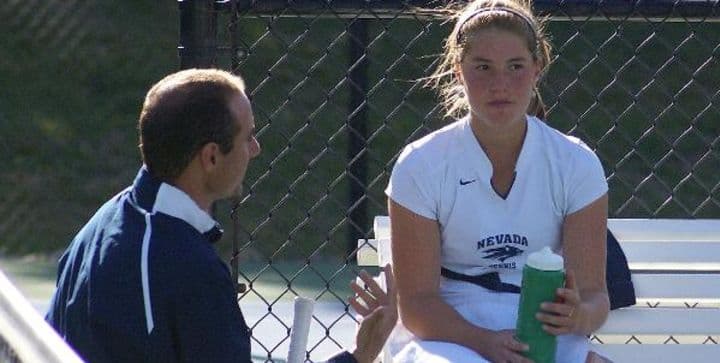
You might have read our blog two weeks ago, in which we went through the following questions:
- Why do student-athletes transfer?
- How do coaches look at transfers?
- How can you avoid transferring?
- How does transferring work? - Will be covered today.
If you don't know the answers to questions 1-3 yet or need a recap, take a quick look here and continue reading then.
It's now time for question 4, in order to understand what necessary steps athletes and coaches need to follow to comply with the rules of transferring:
4. Transferring process
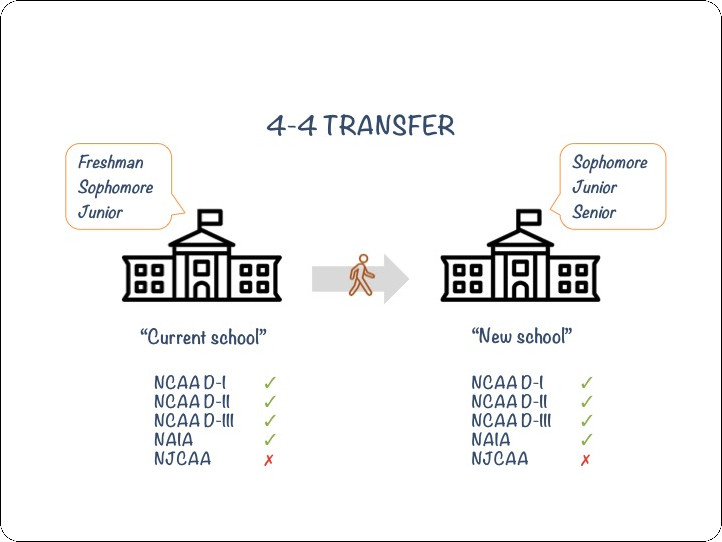
Remember we mentioned the high number of tennis players changing school? This rate only represents 4-4 transfers. But what does that mean in detail? 4-4 stands for a student's transfer from a 4-year college ("current school") to another 4-year college ("new school"). A glimpse on the transfer list will reveal that 4-4 transfers are generally the rule within NCAA D-I. 4-4's include everything from D-I to D-III schools, as well as NAIA schools. The alternative to 4-4 transfers are 2-4 transfers; students change from 2-year colleges (NJCAA) to 4-year colleges and complete their studies.
Given there are four different divisions, comprising 4-year colleges, different sets of rules apply. The graphic below will give you an overview about the main differences:
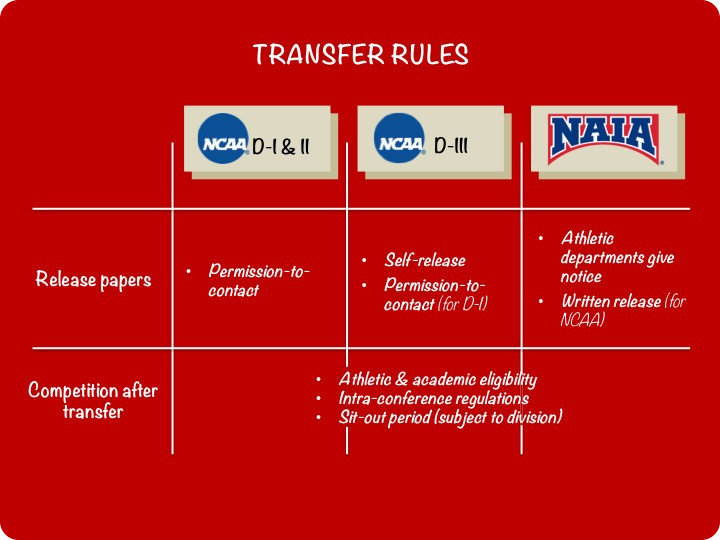
Talk to the coach at your current school
If you feel that you are not happy at the college - could be a lack of the athletic challenge or the school doesn't offer your undergrad program - you need to talk to your coach about it. Chances are he/she is already sort of aware of your thoughts. It could also be that the coach has a feeling about it and approaches you before you even get a chance to. You're in the same boat, and the coach knows you're not gonna be as much of an asset if you feel unwell or you actually don't even want to be on the team. But it is crucial to get the dialogue started!
Receive release papers
NCAA D-I & D-II
"Permission-to-contact" is the official name of the document allowing the coach of a new school to talk to you about a potential transfer. The new school must not contact you before it receives the official permission-to-contact from your current college.
- Note that your current school has the right to deny your request, but will have to justify its decision.
- Note that the same rules apply for athletes wanting to transfer from a NCAA D-III school to a D-I or D-II school.
NCAA D-III
The issue of obtaining release papers is set up a little different for those student-athletes, wanting to transfer within D-III. In contrast to the above described process, students complete an online self-release form, which they then send to the institution to discuss a potential transfer. Permission-to-contact is valid for a 30-day period.
NAIA
There is no specific rule by the NAIA, which tells student-athletes how to go about transferring. If you are a NAIA student and want to transfer to a NCAA school, it is "recommended" you get official permission-to-contact papers from your current college; NCAA schools will not recruit you otherwise.
If you intend to transfer within the NAIA, the athletic departments of the schools notify each other. A formal written release from the athletic department makes your life a lot easier once you have transferred (see more below).
Talk to other schools
Because the release papers need to be college-specific, you have already made a decision which coach you would like to start the dialogue with; that's the school which receives your permission-to-contact papers from your current school's athletic department.
Now it's all up to you to convince the coach that you're just the right fit for his or her team. Remember from the first part of our series on transfers: all coaches have a list of things which they need to check you for. Have you had injuries? Problems in classes? Your behavior? Did you perform well in matches? You wanna make sure to make a rock-solid impression on coaches when you speak to them.
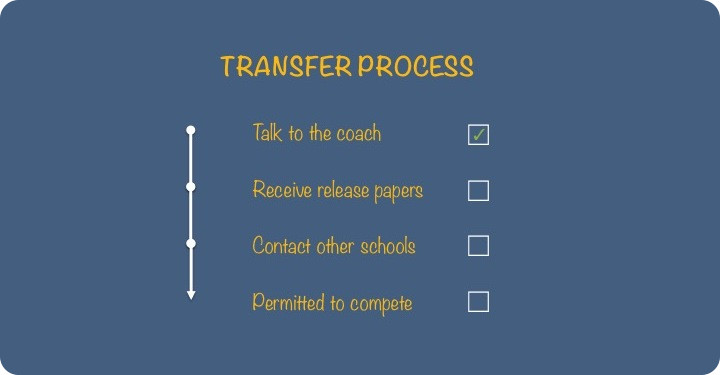
Competing after transferring
For any student-athlete a transfer mostly only makes sense if you can expect to receive an athletic scholarship and play.
NCAA D-I & D-II
The general NCAA rule says that you need to "sit out" for a year; in other words, you spend a year "in residency". But there are several exceptions, which enable athletes to accept a scholarship offer while at the same time maintain eligibility to play. To keep your chances intact there are a couple of things you need to be aware of:
- One-time transfer exception
The #1 most popular exception, enabling student-athletes to compete right from the start at their new college. What's happening is that your new school sends a request to your previous school, which then files a "transfer-release agreement". In other words your previous athletic department gives the formal OK for you to accept athletic scholarship money and participate in collegiate competition for your new school. - Remain academically eligible
Let's keep it very simple. Keep up your performance in the classroom and maintain a solid grade point average. Academic problems at your current school make you a difficult case to transfer. - Remain athletically eligible
Strongly related to the above point. Keep your academic level where it should be and your athletic eligibility will follow suit. - Intra-conference transferring
This is a sensitive topic. Imagine you work for Coca-Cola, you decide to leave, and you start working for Pepsi instead. Not necessarily the best practice and the same accounts for college tennis. Different conferences have different rules on this, and it is advisable to transfer to another conference to avoid these rules.
(E.g. The Mountain West Conference foresees the transfer to sit-out for a full academic year without receiving athletic scholarship money.)
NAIA
For the NAIA, transfer rules are not as strict. As a basic rule, you are required to wait for a 16-week period before you may participate in athletic collegiate events again. However, this rule does not apply if you:
This is it when it comes to transferring college for now. Finally, we'd like to give you a piece of advice. Given the high rate of transfers, we advice you to keep your Smarthlete tennis recruiting profile active. All you'd have to do is change your status from "Searching" or "Negotiating" to "Signed". That way, you are protected from coaches contacting you, but you can easily re-activate your profile if needed after one of the first two years.
And for those of you wondering what this is all about, Smarthlete is a tennis recruiting platform, where you can sign up for free and connect with college coaches right away! Haven't set up a profile yet? Check it out and get started! :)
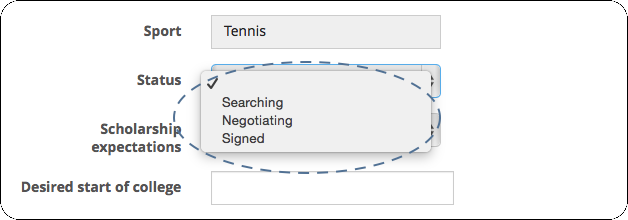
We understand that the topic of transferring is not very easy to understand. That being said, we highly encourage you to just drop us an email with your questions about your specific case to contact@smarthlete.com. We're happy to help!
Make sure you stay informed about what's happening in college tennis, and follow us on Facebook, Instagram, or Twitter.